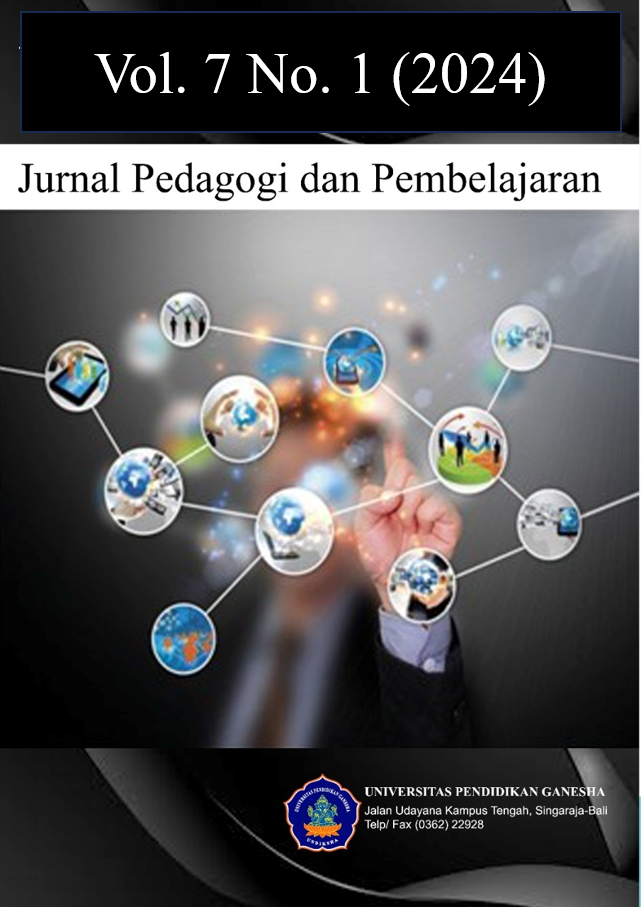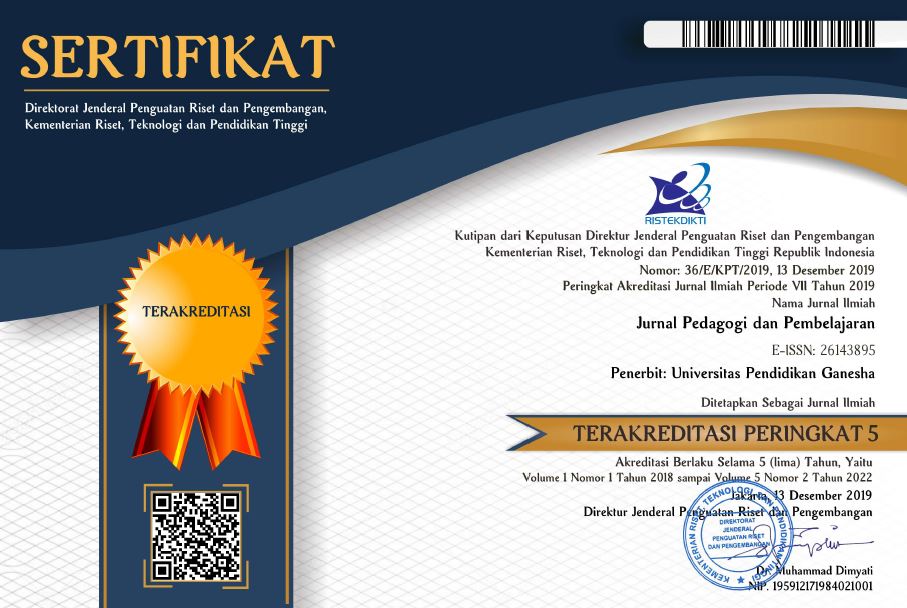The Effects of Emotional Intelligence on Language Learning Strategy Preference among EFL Students
DOI:
https://doi.org/10.23887/jp2.v7i1.64507Keywords:
Emotional Intelligence, Language Learning Strategies, English as a Foreign LanguageAbstract
In the Indonesian EFL context, there has been little discussion regarding the study of learners' emotional intelligence and whether it influences their language learning strategy preferences. The purpose of this research was to analyze whether emotional intelligence has any effect on the language learning preference among Indonesian EFL learners. The main design of this research was based on survey. The instrument used in this study consists of two questionnaires namely TEIQue-SF and SILL. To achieve this goal, thirty Indonesian EFL students participated in the completion of the questionnaires. The sampling technique used was convenience sampling. SPSS 25 was used to perform the analysis of the data. The descriptive findings of the study showed that the most common strategy utilized by EFL students was cognitive strategies, while the least preferred strategy was affective strategy. It was revealed that there is a significant correlation between emotional intelligence and strategies for learning languages (p 0.001). Learners who have a higher level of emotional intelligence use a wider variety of strategies than students who have a lower level of emotional intelligence. There were considerable disparities between the two groups in terms of the strategies that they chose to implement. In conclusion, pedagogical implications as well as findings were examined.
References
Alasmari. (2020). The mind of a good language learner: A case study of vocabulary-learning strategies. International Journal of English Language Education, 8(1), 34–36. https://doi.org/10.5296/ijele.v8i1.16116. DOI: https://doi.org/10.5296/ijele.v8i1.16116
Alfian, A. (2021). The favored language learning strategies of Islamic university EFL learners. Studies in English Language and Education, 8(1), 47–64. https://doi.org/10.24815/siele.v8i1.17844. DOI: https://doi.org/10.24815/siele.v8i1.17844
Amjah, D. Y. P. H. (2014). A Study of Teachers’ Strategies so Develop Students’ Interest towards Learning English as a Second Language. Procedia - Social and Behavioral Sciences, 134, 188–192. https://doi.org/10.1016/j.sbspro.2014.04.238. DOI: https://doi.org/10.1016/j.sbspro.2014.04.238
Ampera, D., Iskandar, Y., Tabieh, A. A. S., & Soomro, Z. A. (2021). The role of visuals in cultural learning in the EFL classroom. Asian ESP Journal, 17(3), 111–125. https://www.researchgate.net/profile/Zubair-Soomro.
Barkhordari, M., Rostambeygi, P., & Ghasemnejad, M. (2016). Measuring emotional intelligence of nursing student. Iranian Journal of Nursing Research, 10(4), 12–19. http://ijnr.ir/article-1-1623-en.html.
Barnwell, D., O’Malley, J. M., & Chamot, A. U. (1991). Learning Strategies in Second Language Acquisition. Language, 67(2). https://doi.org/10.2307/415153. DOI: https://doi.org/10.2307/415153
Braun, V., Clarke, V., Boulton, E., Davey, L., & McEvoy, C. (2021). The online survey as a qualitative research tool. International Journal of Social Research Methodology, 24(6), 641–654. https://doi.org/10.1080/13645579.2020.1805550. DOI: https://doi.org/10.1080/13645579.2020.1805550
Dawadi, S. (2017). Language learning strategies profiles of EFL learners in Nepal. European Journal of Educational and Social Sciences, 2(2), 42–55. https://eric.ed.gov/?id=ED578188.
Ehrman, M. E., Wenden, A., & Rubin, J. (1990). Learner Strategies in Language Learning. The Modern Language Journal, 74(4). https://doi.org/10.2307/328531. DOI: https://doi.org/10.2307/328531
Eldridge, B. A. (2014). Exploring Faculty Adoption and Utilization of Blackboard at a Community College in the Kentucky Community and Technical College System.
Enz, S., Zoll, C., Vannini, N., Schneider, W., Hall, L., Paiva, A., & Aylett, R. (2007). E-motional learning in primary schools: Fearnot! an anti-bullying intervention based on virtual role-play with intelligent synthetic characters. ECEL 2007: 6th European Conference on e-Learning, 6(2), 217–224. https://academic-publishing.org/index.php/ejel/article/view/1536.
Fatimah, A. S., & Santiana, S. (2017). Teaching in 21St Century: Students-Teachers’ Perceptions of Technology Use in the Classroom. Script Journal: Journal of Linguistic and English Teaching, 2(2), 125. https://doi.org/10.24903/sj.v2i2.132. DOI: https://doi.org/10.24903/sj.v2i2.132
Goleman, D. (1995). Emotional Intelligence: Why It Can Matter More Than IQ? Bantam Books.
Hafeman, D. M., Ostroff, A. N., Feldman, J., Hickey, M. B., Phillips, M. L., Creswell, D., Birmaher, B., & Goldstein, T. R. (2020). Mindfulness-based intervention to decrease mood lability in at-risk youth: Preliminary evidence for changes in resting state functional connectivity. Journal of Affective Disorders, 276(April), 23–29. https://doi.org/10.1016/j.jad.2020.06.042. DOI: https://doi.org/10.1016/j.jad.2020.06.042
Hau, N. H., Cuong, T. V., & Tinh, T. T. (2020). Students and Teachers’ Perspective Of The Importance Of Arts In STEAM Education In Vietnam. Journal of Critical Reviews, 7(11), 666–671. https://doi.org/10.31838/jcr.07.11.121.
Kanesan, P., & Fauzan, N. (2019). Models of emotional intelligence: A review. E-BANGI Journal, 16(7), 1–9. http://journalarticle.ukm.my/20058/1/34511-107724-1-SM.pdf.
Khurshid, M. A., Majoka, M. I., & Khan, M. S. (2018). Development of Emotional Intelligence of University Students: An Investigation of the Effect of Curricular Activities. Pakistan Journal of Distance and Online Learning, 4(1), 215–234. https://eric.ed.gov/?id=EJ1267256.
Kurniansyah, H., & Daveta, N. (2018). The Influence Of Intelligent Intellectual, Emotional and Spiritual On Accounting Uderstanding. Proceeding International Conference on Information Technology and Business, 132–144. https://jurnal.darmajaya.ac.id/index.php/icitb/article/view/1387.
Lee, J., & Heinz, M. (2016). English Language Learning Strategies Reported By Advanced Language Learners. Journal of International Education Research (JIER), 12(2), 67–76. https://doi.org/10.19030/jier.v12i2.9629. DOI: https://doi.org/10.19030/jier.v12i2.9629
Licorish, S. A., Owen, H. E., Daniel, B., & George, J. L. (2018). Students’ perception of Kahoot!’s influence on teaching and learning. Research and Practice in Technology Enhanced Learning, 13(1). https://doi.org/10.1186/s41039-018-0078-8. DOI: https://doi.org/10.1186/s41039-018-0078-8
Mattarima, K., & Hamdan, A. R. (2011). Understanding students’ learning strategies as an input context to design English classroom activities. International Journal of Psychological Studies, 3(2), 328–348. https://doi.org/10.5539/ijps.v3n2p238. DOI: https://doi.org/10.5539/ijps.v3n2p238
Mayer, J. D., Salovey, P., & Caruso, D. R. (2009). Psychological Inquiry: An International Journal for the Advancement of Psychological Theory. In Emotional Intelligence : Theory , Findings , and Implications " Emotional Intelligence : Theory , Findings , and Implications (pp. 37–41). https://doi.org/10.1207/s15327965pli1503.
Mulyani, S. (2020). Language Learning Strategies of Successful EFL Learners. International Journal in Applied Linguistics of Parahikma, 2(1), 31–39. https://doi.org/https://journal.parahikma.ac.id/ijalparahikma/article/view/35.
Murphy, A., & Janeke, H. C. (2009). The relationship between thinking styles and emotional intelligence: An exploratory study. South African Journal of Psychology, 39(3), 357–375. https://doi.org/10.1177/008124630903900310. DOI: https://doi.org/10.1177/008124630903900310
Parlato-Oliveira, E., Chetouani, M., Cadic, J.-M., Viaux, S., Ghattassi, Z., Xavier, J., Ouss, L., Feldman, R., Muratori, F., Cohen, D., & Saint-Georges, C. (2020). The emotional component of Infant Directed-Speech: A cross-cultural study using machine learning. Neuropsychiatrie de l’Enfance et de l’Adolescence, 68(2), 106–113. https://doi.org/10.1016/j.neurenf.2019.10.004. DOI: https://doi.org/10.1016/j.neurenf.2019.10.004
Pawlak, M. (2018). Grammar learning strategy inventory (GLSI): Another look. Studies in Second Language Learning and Teaching, 8(2 Special Issue), 351–379. https://doi.org/10.14746/ssllt.2018.8.2.8. DOI: https://doi.org/10.14746/ssllt.2018.8.2.8
Philippe, S., Souchet, A. D., Lameras, P., Petridis, P., Caporal, J., Coldeboeuf, G., & Duzan, H. (2020). Multimodal teaching, learning and training in virtual reality: a review and case study. Virtual Reality and Intelligent Hardware, 2(5), 421–442. https://doi.org/10.1016/j.vrih.2020.07.008. DOI: https://doi.org/10.1016/j.vrih.2020.07.008
Rahimi, M., & Yadollahi, S. (2017). Effects of offline vs. online digital storytelling on the development of EFL learners’ literacy skills. Cogent Education, 4(1). https://doi.org/10.1080/2331186X.2017.1285531. DOI: https://doi.org/10.1080/2331186X.2017.1285531
Ramadani, A., & Xhaferi, B. (2020). Teachers’ Experiences with Online Teaching Using the Zoom Platform with EFL Teachers in High Schools in Kumanova. SEEU Review, 15(1), 142–155. https://doi.org/10.2478/seeur-2020-0009. DOI: https://doi.org/10.2478/seeur-2020-0009
Ramsin, A., & Mayall, H. J. (2019). Assessing ESL learners’ online learning self-efficacy in Thailand: Are they ready? Journal of Information Technology Education: Research, 18, 467–479. https://doi.org/10.28945/4452. DOI: https://doi.org/10.28945/4452
Sadiku, L. M. (2015). The Importance of Four Skills Reading, Speaking, Writing, Listening in a Lesson Hour. European Journal of Language and Literature, 1(1), 29. https://doi.org/10.26417/ejls.v1i1.p29-31. DOI: https://doi.org/10.26417/ejls.v1i1.p29-31
Santihastuti, A., & Wahjuningsih, E. (2019). The learning strategies used by EFL students in learning English. Indonesian Journal of English Education, 6(1), 10–20. https://doi.org/10.15408/ijee.v6i1.12111. DOI: https://doi.org/10.15408/ijee.v6i1.12111
Santosa, M. H. (2017). Learning approaches of Indonesian EFL Gen Z students in a flipped learning context. Journal on English as a Foreign Language, 7(2), 183–208. https://doi.org/10.23971/jefl.v7i2.689. DOI: https://doi.org/10.23971/jefl.v7i2.689
Shatalebi, B., Sharifi, S., Saeedian, N., & Javadi, H. (2012). Examining the relationship between emotional intelligence and learning styles. Procedia - Social and Behavioral Sciences, 31, 95–99. https://doi.org/10.1016/j.sbspro.2011.12.022. DOI: https://doi.org/10.1016/j.sbspro.2011.12.022
Sultan, A. D., & Bancong, H. (2017). Pengaruh Pendekatan Multiple Intelligences Melalui Model Pembelajaran Langsung Terhadap Sikap Dan Hasil Belajar Fisika Peserta Didik Kelas XI IPA SMA Negeri 11 Makassar. Jurnal Pendidikan Fisika Unismuh, 5(1), 120620. https://doi.org/10.26618/jpf.v5i1.341.
Taheri, L., & Jadidi, E. (2016). The Relationship between Emotional Intelligence and Learning Strategies among Iranian EFL Learners. Theory and Practice in Language Studies, 6(5), 952. https://doi.org/10.17507/tpls.0605.06. DOI: https://doi.org/10.17507/tpls.0605.06
Tam, K. C.-H. (2013). A study on language learning strategies (LLSs) of university students in Hong Kong. Taiwan Journal of Linguistics, 11(2), 1–42. https://doi.org/10.6519/TJL.2013.11(2).1.
Thompson, Claire, Kuah, Adrian, Foong, Regina, & Eddy, N. (2020). The Development of Emotional Intelligence, Self-Efficacy and Locus of Control in MBA Students. Human Resource Development Quarterly, 31(1), 1–37. https://doi.org/10.1002/hrdq.21375. DOI: https://doi.org/10.1002/hrdq.21375
Winarno, A., Fedin, M. Y. A., & Salleh, N. H. M. (2022). the Effect of Technological Literacy, Learning Facility, and Family Environment on Students’ Learning Motivation. Jurnal Pendidikan: Teori, Penelitian, Dan Pengembangan, 7(7), 246. https://doi.org/10.17977/jptpp.v7i7.15404. DOI: https://doi.org/10.17977/jptpp.v7i7.15404
Wiyono, K., Ismet, I., Noprianti, N., Permawati, H., Saparini, S., & Zakiyah, S. (2019). Interactive multimedia using multiple-intelligences-based in the lesson of thermodynamics for high school. Journal of Physics: Conference Series, 1166(1). https://doi.org/10.1088/1742-6596/1166/1/012014. DOI: https://doi.org/10.1088/1742-6596/1166/1/012014
Zafari, M., & Biria, R. (2014). The relationship between emotional intelligence and language learning strategy use. https://doi.org/10.1016/j.sbspro.2014.03.630. DOI: https://doi.org/10.1016/j.sbspro.2014.03.630
Zare, P. (2012). Language learning strategies among EFL/ESL learners a review of literature. International Journal of Humanities and Social Science, 2(5), 162–169. https://doi.org/https://scirp.org/reference/referencespapers.aspx?referenceid=3077001.
Downloads
Published
How to Cite
Issue
Section
License
Copyright (c) 2023 Liana Buruuja Nisa, Ashadi

This work is licensed under a Creative Commons Attribution-ShareAlike 4.0 International License.
Authors who publish with Jurnal Pedagogi dan Pembelajaran agree to the following terms:
- Authors retain copyright and grant the journal the right of first publication with the work simultaneously licensed under a Attribution-ShareAlike 4.0 International (CC BY-SA 4.0) that allows others to share the work with an acknowledgment of the work's authorship and initial publication in this journal
- Authors are able to enter into separate, additional contractual arrangements for the non-exclusive distribution of the journal's published version of the work (e.g., post it to an institutional repository or publish it in a book), with an acknowledgment of its initial publication in this journal.
- Authors are permitted and encouraged to post their work online (e.g., in institutional repositories or on their website) prior to and during the submission process, as it can lead to productive exchanges, as well as earlier and greater citation of published work. (See The Effect of Open Access)











